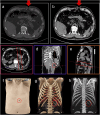The evolution of postmortem investigation: a historical perspective on autopsy's decline and imaging's role in its revival
- PMID: 40296874
- PMCID: PMC12034628
- DOI: 10.3389/fradi.2025.1565012
The evolution of postmortem investigation: a historical perspective on autopsy's decline and imaging's role in its revival
Abstract
Autopsy is generally regarded as the gold standard for cause of death determination, the most accurate contributor to mortality data. Despite this, autopsy rates have substantially declined, and death certificates are more frequently completed by clinicians. Substantial discrepancies between clinician-presumed and autopsy-determined cause of death impact quality control in hospitals, accuracy of mortality data, and, subsequently, the applicability and effectiveness of public health efforts. This problem is compounded by wavering support for the practice of autopsy by accrediting bodies and academic bodies governing pathology specialty training. In forensic settings, critical workforce shortages combined with increased workloads further threaten sustainability of the practice. Postmortem imaging (PMI) can help mitigate these ongoing problems. Postmortem computed tomography can help clarify manner and cause of death in a variety of situations and has undeniable advantages, including cost reduction, the potential to review data, expedient reporting, archived unaltered enduring evidence (available for expert opinion, further review, demonstrative aids, and education), and (when feasible) adherence to cultural and religious objections to autopsy. Integration of radiology and pathology is driving a transformative shift in medicolegal death investigations, enabling innovative approaches that enhance diagnostic accuracy, expedite results, and improve public health outcomes. This synergy addresses declining autopsy rates, the forensic pathologist shortage, and the need for efficient diagnostic tools. By combining advanced imaging techniques with traditional pathology, this collaboration elevates the quality of examinations and advances public health, vital statistics, and compassionate care, positioning radiology and pathology as pivotal partners in shaping the future of death investigations.
Keywords: autopsy; forensic medicine; pathology; postmortem computed tomography (PMCT); postmortem imaging; radiology; virtual autopsy.
© 2025 Solomon, Gascho, Adolphi, Filograna, Sanchez, Gill and Elifritz.
Conflict of interest statement
The authors declare that the research was conducted in the absence of any commercial or financial relationships that could be construed as a potential conflict of interest. The author(s) declared that they were an editorial board member of Frontiers, at the time of submission. This had no impact on the peer review process and the final decision.
Figures


Similar articles
-
Early Experience With Postmortem CT Imaging.J Comput Assist Tomogr. 2025 Apr 23. doi: 10.1097/RCT.0000000000001732. Online ahead of print. J Comput Assist Tomogr. 2025. PMID: 40268276
-
Technical and interpretive pitfalls of postmortem CT: Five examples of errors revealed by autopsy.J Forensic Sci. 2022 Jan;67(1):395-403. doi: 10.1111/1556-4029.14883. Epub 2021 Sep 7. J Forensic Sci. 2022. PMID: 34491573
-
[Development of forensic thanatology through the prism of analysis of postmortem protocols collected at the Department of Forensic Medicine, Jagiellonian University].Arch Med Sadowej Kryminol. 2011 Jul-Sep;61(3):213-300. Arch Med Sadowej Kryminol. 2011. PMID: 22393873 Polish.
-
Postmortem CT in Trauma: An Overview.Can Assoc Radiol J. 2020 Aug;71(3):403-414. doi: 10.1177/0846537120909503. Epub 2020 Mar 16. Can Assoc Radiol J. 2020. PMID: 32174147 Review.
-
VIRTual autOPSY-applying CT and MRI for modern forensic death investigations.Front Radiol. 2025 May 12;5:1557636. doi: 10.3389/fradi.2025.1557636. eCollection 2025. Front Radiol. 2025. PMID: 40421097 Free PMC article. Review.
References
-
- Hurren ET. Wellcome Trust–Funded Monographs and Book Chapters. Dissecting the Criminal Corpse: Staging Post-Execution Punishment in Early Modern England. Basingstoke, UK: Palgrave Macmillan; (2016. © The Editor(s) (if applicable) and the Author(s) 2016. - PubMed
-
- Hill RB, Anderson RE. The recent history of the autopsy. Arch Pathol Lab Med. (1996) 120(8):702–12. - PubMed
-
- Sblano S, Arpaio A, Zotti F, Marzullo A, Bonsignore A, Dell'Erba A. Discrepancies between clinical and autoptic diagnoses in Italy: evaluation of 879 consecutive cases at the “policlinico of Bari” teaching hospital in the period 1990–2009. Ann Ist Super Sanita. (2014) 50(1):44–8. 10.4415/ANN_14_01_07 - DOI - PubMed
LinkOut - more resources
Full Text Sources

